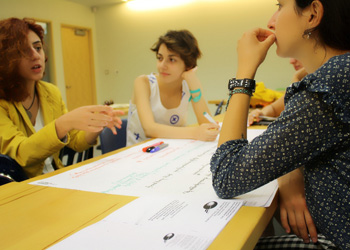Day Two: Actions and Engagement Opportunities for Armenians

We are sharing part three of the report, to introduce some of the main engagement opportunities that were discussed.
January 20 – Today’s Questions:
How do you think we can enhance collaboration between Armenia and the diaspora?
Do you think diasporan institutions are effective?
Engagement with Armenia
Since 1988, many Armenians in the diaspora have engaged with Armenia through various means, from humanitarian aid to repatriation, from higher education to civil society support. The relationship has had several ups and downs, but the engagement has been constant. Nevertheless, diasporas’ involvement has been much less than the full potential possible. Remarkably, there is little serious research undertaken to date to explore the obstacles to enhanced Armenia-diaspora(s) collaboration, and to suggest appropriate “models” for development. Thorny questions pertaining to conflicting interests, lack of trust and how to overcome it, collective psychology and cultural differences, issues of capacity and capability are rarely asked and much less analysed objectively. They need to be addressed in a non-politicised manner.
There are many more specific issues that require research. Diasporan engagement with Armenia tends to be haphazard, often reflecting the interests and impulses of the diasporan organisations and individuals rather than the actual needs of the country. It is not difficult to compile a long list of needs, including:
The Institutional Sustainability of the Diaspora
Five points need to be made in this context, pertaining to possible institutional transformations.
First, established (i.e. post-Genocide) Armenian diasporan communities are moving beyond the old organisational model in terms of intracommunity political and social divides, particularly in North America, Europe and to some degree in Lebanon. New types of intra-community communication networks and mobilisation strategies are needed to deal with new dynamics, reflecting the fact that the “iron curtain” within the diaspora has been opened significantly. Moreover, new divisions have emerged in many cities, namely between the established diaspora and the new post-Soviet diaspora, necessitating new institutional set-ups.
Second, unlike the first generation of post-Genocide migrants, three to four generations later, Armenians in the diaspora are integrated within their “host societies.” In fact, in the established diaspora, the immigrant/ host society dichotomy no longer makes sense. Consequently, institutions that seek to somehow employ the “us” and “them” division between Armenian identity and other identities lose significance with the younger generation who need markers of identity that combine the “us” and the “them.” This is particularly the case in the Western diaspora, but also relevant in the Middle East, as well as in Russia and Eastern Europe. For example, in the Middle East, for Armenians to survive and prosper, they need to engage with Arab intellectuals and be active in Arab civil society. Arab nationalist narrative has traditionally viewed Armenians as “foreigners” rather than a local Christian community.
Third, and following from the above, networks based on professional considerations are becoming increasingly popular, whereby mobilisation takes place around a common interest or a specific goal (e.g. “skills donation,” exchange programmes and locally-led projects). Identity issues could be one component, but it is rarely the only or even primary element of such activities. Part of the necessary re-imagination of institutions entails moving away from charitable acts and focusing more on entrepreneurship, supporting young start-ups and offering young people work opportunities within successful organisations run by influential Armenians or sympathisers.
Fourth, the excellence of existing Armenian institutions – from education to community services – is a must. Gone are the days where Armenians gravitate toward Armenian organisations just because they are Armenian. Parents, for instance, insist on high quality schools; youth want their local clubs to be connected to global networks and issues, using the latest technologies and know-how. There is a slew of challenges facing diasporan institutions to “scale up” quality to remain attractive to their members and users.
Finally, financial models of community maintenance need to be rethought. The established Armenian diaspora is a self-sustaining diaspora through donations and forms of voluntary “taxation.” Is this model sufficient or does it need to be “scaled up” as well to attract new philanthropists and local government support?
Write to us on [email protected] and join the discussions online by following our social media partners.
Please use the official hashtag #Armenians2115
